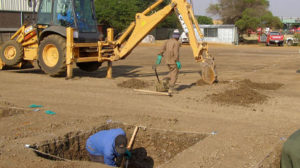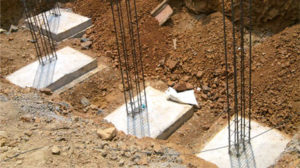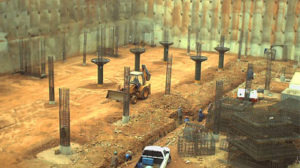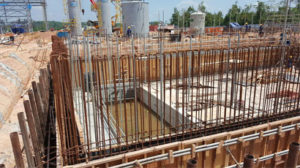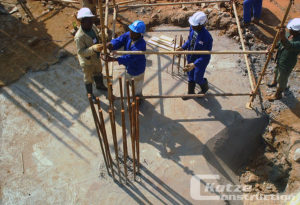Broadly speaking, all foundations are divided into two categories: shallow foundations and deep foundations. The words shallow and deep refer to the depth of soil in which the foundation is made. Shallow foundations can be made in depths of as little as 1m, while deep foundations can be made at depths of 20 - 65m. Shallow foundations are used for small, light buildings, while deep ones are for large, heavy buildings.
SHALLOW FOUNDATIONS
Are also called spread footings or open footings. The 'open' refers to the fact that the foundations are made by first excavating all the earth till the bottom of the footing, and then constructing the footing. During the early stages of work, the entire footing is visible, and is therefore called an open foundation. The idea is that each footing takes the concentrated load of the column and spreads it out over a large area, so that the actual weight on the soil does not exceed the safe bearing capacity of the soil.
Individual footings
Are one of the most simple and common types of foundations. These are used when the load of the building is carried by columns. Usually, each column will have its footing. The footing is just a square or rectangular pad of concrete on which the column sits. To get a very rough idea of the size of the footing, the engineer will take the total load on the column and divide it by the safe bearing capacity (SBC) of the soil.
Strip footings
Are commonly found in load-bearing masonry construction, and act as a long strip that supports the weight of an entire wall. These are used where the building loads are carried by entire walls rather than isolated columns, such as in older buildings made of masonry.
DEEP FOUNDATIONS
Pile Foundations
A pile is a long cylinder of a strong material such as concrete that is pushed into the ground so that structures can be supported on top of it.
Pile foundations are used in the following situations:
- When there is a layer of weak soil at the surface. This layer cannot support the weight of the building, so the loads of the building have to bypass this layer and be transferred to the layer of stronger soil or rock that is below the weak layer.
- When a building has very heavy, concentrated loads, such as in a high rise structure.
Pile foundations are capable of taking higher loads than spread footings.
